Digital Beauty : How Sephora leveraged digital technology to overhaul the in-store experience.

Sephora, a French cosmetics chain founded in 1969 and currently under the LVHM umbrella, harnessed the digital revolution to become an epitome of an omnichannel business; converting, delighting and retaining consumers with connected and curated beauty experiences across online and offline channels.
What was the opportunity?
In a world filled with uber-connected and hyper-informed consumers, expectations of what constitutes as a compelling retail experience is constantly being shifted. In its early years, Sephora differentiated itself by allowing consumers to try products in-store before purchasing, something unprecedented in the cosmetic retail models prevalent at the time [1]. Today, Sephora has embraced the full spectrum of retail digital technology available to continue to create disruptive and differentiated in-store experiences, delivered through an innovative operating model that creatively integrates physical and digital elements of the consumer journey.
The new digital stores: Sephora’s brick and mortar stores are iconic and while it was an early adopter of e-commerce, Sephora insists that the physical store is still the nerve center of the company [2]. Digitizing the store became a priority and Sephora has unveiled its new range of stores that ingeniously combine offline and online components. A robot greets consumers at the entrance, giving them a card that serves as a virtual shopping basket [3]. These stores are smaller in size and carry limited physical products, generating significant cost efficiencies in inventory and rent but is complemented with a digital catalogue of over 14000 products that consumers can add to their digital basket right away in the store using the card [4]. Positioning the physical store as a doorway to the website is intriguing in its effort to bridge the online-offline gap while still prioritizing the brick-and-mortar stores.
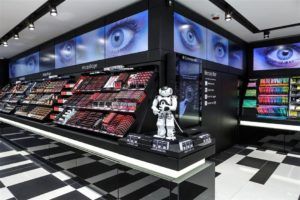
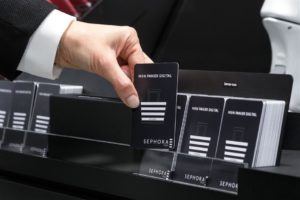
Images – [L] : Welcome robot at the new digital store in Paris, [R] : Digital tag cards to use in-store, Source : LVMH
NFC tags enable consumers to place products on connected screens and get all the information they need on it [5]. The stores also provide makeover workshops through video tutorials and a digital selfie mirror at the store allows consumers to take a photo of themselves trying on the products and then share via social media [6]. As they leave the store, consumers can go to the Mini-Beautic, a product sample vending machine and receive samples in real-time [7].
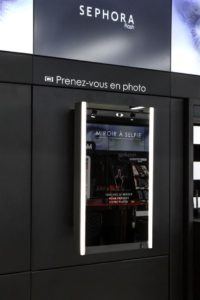
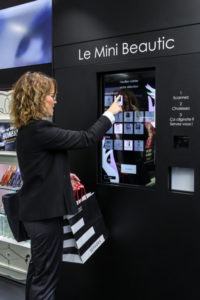
Images – [L] : Selfie-mirror at the Sephora digital store, [R]: Mini-Beautic sampling service, Source : LVMH
Mobile and Augmented Reality: Augmenting the offline-online philosophy, Sephora’s app utilizes beacons to recognize when users are inside a store and notifies them with an in-store map, daily promotions, their online shopping cart and wish list [8]. The app also recently incorporated augmented reality by allowing consumers to scan images on Sephora store windows and product packaging to receive customized, interactive beauty content [9].
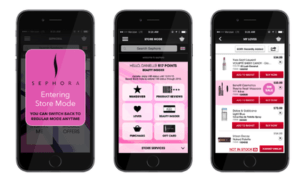
Image: Store-mode on the Sephora-To-Go mobile app.
Virtual Personalization Digitizing Sephora’s ethos of allowing consumers to try on products pre-purchase, the Sephora Virtual Artist is a personal, virtual make-up app that takes a photo of the consumer’s face and lets users swipe through hundreds of lipstick colors to virtually test compatibility [10]. In like vein, Sephora also has an application called Pocket Contour that helps consumers identify their face shape and then offers tailored step-by-step guidance on how to use make-up to contour their faces [11]. At the store, Sephora employees use a hand-held device called ColorIQ to scan your face and capture your exact skin shade which is matched to an extensive library to provide a unique 4-digit color code to each consumer. Using the code, you can then begin to identify the products that are most well-suited to your specific skin tone. Once you obtain a colorIQ, you can use it online and on mobile for a highly targeted product selection [12].
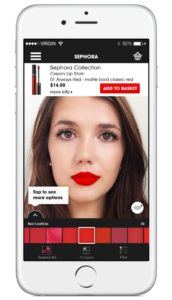
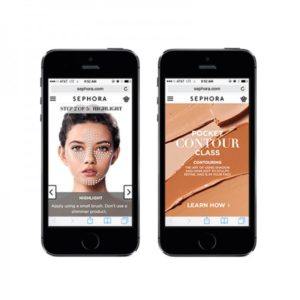
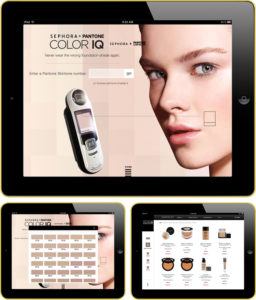
Images – [L]: Sephora Virtual Artist Lipstick shade tester, [M] :Sephora Pocket Contour App, [R] : Sephora ColorIQ Device and Personalization
While Sephra’s operating model that blurs digital and analogue interactions is praise-worthy, digital retailing is ripe with innovation and below are a few areas Sephora should continue to invest in to ensure that they push the envelope in digital beauty.
Smart Cosmetics : With Loreal, we have already seen that IoT has now infiltrated cosmetic products [13] and in the future, the Sephora branded products themselves may function as smart, connected cosmetic products that can measure and track data on the consumer and transmit back.
3D Printed Cosmetics : With Color IQ, Virtual Artist and Pocket-Contour, Sephora has already set the stage for consumers to tailor their make-up products based on skin tone and in the near future, could enable them to print out their customized shades right there in the store if needed, taking personalization to a whole new level.
Data : All of Sephora’s personalization initiatives generate a multitude of powerful data on their consumers’ behaviors, preferences and lifestyles. This is data that can be incredibly useful, not just for Sephora but also for the other cosmetic brands that they carry. Monetizing on the consumer data generated with their supplier brands is one option but more importantly, Sephora needs to think through how to effectively utilize this data mine to extract valuable insights that can inform their product development, future marketing efforts and strategy more effectively.
Word Count : 796
APPENDIX:
[1] J Bornstein, D McGinn, “How Sephora Reorganized to Become a More Digital Brand”, Harvard Business Review, https://hbr.org/2014/06/how-sephora-reorganized-to-become-a-more-digital-brand, accessed on 16 November 2016
[2] Ibid
[3] The Star : “Sephora welcomes connected beauty with a new 3.0 store experience”, http://www.thestar.com.my/tech/tech-news/2015/10/23/sephora-welcomes-connected-beauty-with-a-new-30-store-experience/, accessed on 15 November 2016
[4] LVMH : “Sephora Flash, the connected beauty store”, https://www.lvmh.com/news-documents/news/sephora-flash-the-connected-beauty-store/, accessed on 16 November 2016
[5] Ibid
[6] The Star : “Sephora welcomes connected beauty with a new 3.0 store experience”, http://www.thestar.com.my/tech/tech-news/2015/10/23/sephora-welcomes-connected-beauty-with-a-new-30-store-experience/, accessed on 15 November 2016
[7] Ibid
[8] B.Thau, “Sephora Bets Big On Digital Growth With Disruptive ‘Experiences’, Forbes, http://www.forbes.com/sites/barbarathau/2015/03/06/sephora-grooms-digital-leaders-with-innovation-lab-debuts-mobile-experiences/#3ed98dc5553e, accessed on 15 November 2016
[9] Ibid
[10] N.Creegan, “How Sephora is revealing the future of augmented reality in fashion”, https://centricdigital.com/blog/digital-trends/how-sephora-is-revealing-the-future-of-augmented-reality-in-fashion/, accessed on 14 November 2016
[11] C.Tode, “Sephora shapes mobile personalization with tailored, step-by-step experience”, http://www.mobilecommercedaily.com/sephora-shapes-mobile-personalization-with-tailored-step-by-step-app, accessed on 15 November 2016
[12] H.Milnes, “How Color IQ, Sephora’s shade-matching skin care tool, boosts brand loyalty”, http://digiday.com/brands/color-iq-sephoras-shade-matching-skin-care-tool-boosts-brand-loyalty/, accessed on 14 November 2016
[13] S.Ghosh, “Connected mascara? L’Oreal explores the Internet of Things”, http://www.campaignlive.com/article/connected-mascara-loreal-explores-internet-things/1364406#tYBCoBLjgkRkwTla.99, accessed on 16 November 2016



Thanks, Parvathy – it was really interesting to read about all of the different channels Sephora utilizes to sell products. I wonder how successful the new, smaller digital stores will be, however. It seems to me that customers who are taking the time to shop in person, rather than simply online, will want to be able to take all of the physical products home with them at time of sale. Do you think that having to wait for their purchases to be delivered might be viewed as too much of an inconvenience and result in customers avoiding these stores in favor of the larger, traditional versions?
Parvathy – fascinating article! When I compare this new personalization technology against traditional make-up sell strategies, I can see that it may attract a new type of customer base. In traditional make-up sell strategies such as those found on the first floor of Macy’s or Nordstrom, large numbers of sales associates get into the customers’ faces and try to have awkward conversations with them. However, a robot greeter or even augmented reality mirrors could really help break down those boundaries, and I believe that jives well with the millennial customer who lives life on the go and cares more about efficiency than a high touch environment. Finally, with a saved online version of the customer’s skin type, facial structure, and make-up desires, customers using this new Sephora technology can pursue more dramatic looks that they would feel uncomfortable putting on themselves but feel fine testing in a computer simulated model. This is a compelling business idea and I would be excited to see its success play out.
Paro, fascinating post. I’ve never set foot in a Sephora store, but was really impressed with their ability to digitize the brick and mortar experience.
It’s very wise to have the store monitors show what your face could look like with different makeup styles. Although one could assume this could be done at home on a computer, people’s computer screens and even mobile devices have subtle differences in color hue. For picking the nuances of a lipstick color, Sephora’s high quality in-store monitors help alleviate this risk. NDG had a great point on customer’s being OK to not take a product home after selecting it in store. I wonder if Sephora can partner with Amazon or another future similar Prime Now service that can deliver the product within hours. This may pacify customer’s need for the product, since having to wait 2-4 business days to receive purchased goods is quite long in our culture. Who knows – in the future a drone may be able to deliver it by the time the consumer gets home!
What a great post Parvathy! As a Sephora enthusiast I’ve been excited about the steps they’ve taken to embrace digital 🙂 I remember what a big deal it was when they came out with ColorIQ. It made it so much easier to choose foundation, both online and in store (which is one of the hardest parts of doing one’s makeup). A big risk I see as things move more digital is that nothing is stopping customers from purchasing products directly from brands rather than through Sephora. One of the allures of Sephora is that you can go one place and try products from all the top brands which is well worth the downside that Sephora doesn’t carry their full lines. As Sephora makes it easier to make purchases online, I see other makeup brands following suit; thus making it harder to compel consumers to buy from them rather than directly from the brand. To keep customers buying from Sephora I think it’s important that they continue to invest in their VIB loyalty program which gives consumers points for every dollar spent at the store.
Great analysis, Parvathy! Sephora does a remarkable job in revolutionizing the beauty sector. From the areas of development that you outlined, I am personally excited about 3D Printed Cosmetics. Did you know that in one of Sephora’s stores customers can also use one of 12 work stations to take a makeup class taught by experienced associates and supported via video tutorials? They can also browse the digital beauty board which showcases the best user-generated content and allows them to filter images for their skin tone, type and color (source:guided-selling.org/digital-technologies-beauty-sector/) (Dear Admin, as I’m not sure what are the commenting rules on your website, I have made the link inactive, please activate it if that’s allowed. Thanks!)